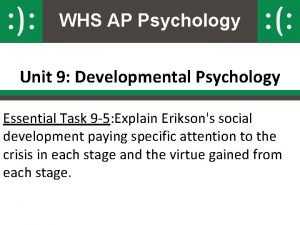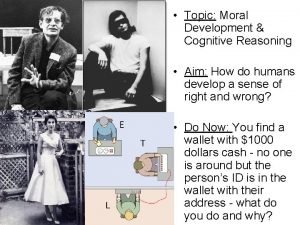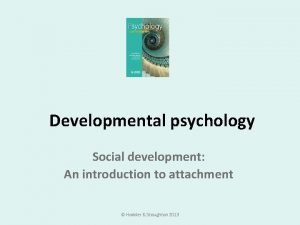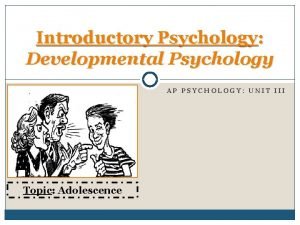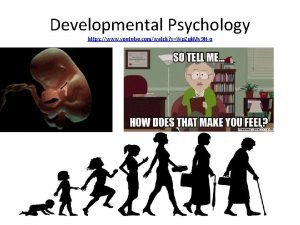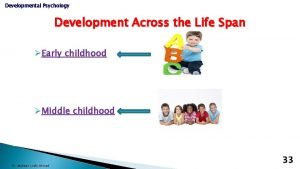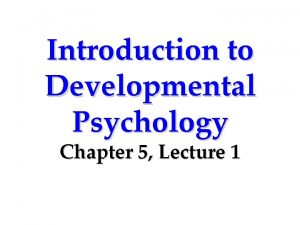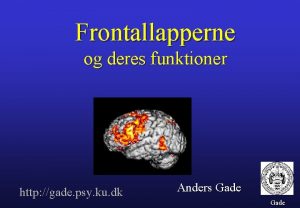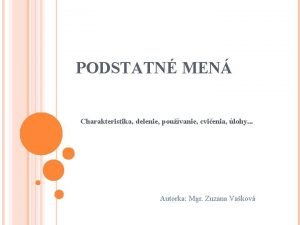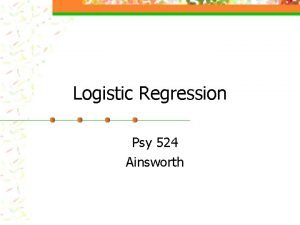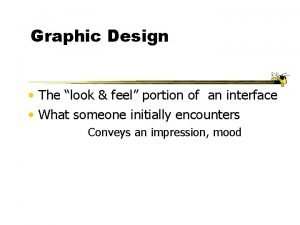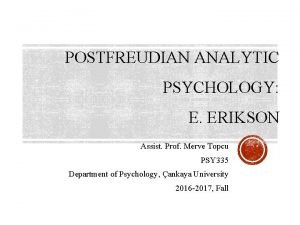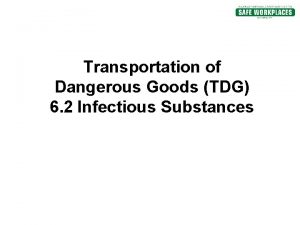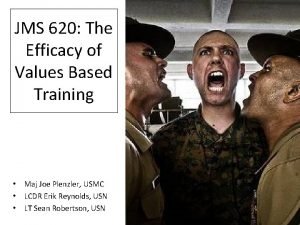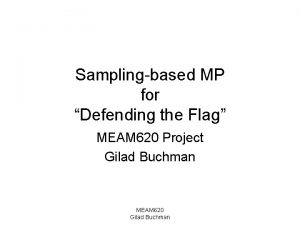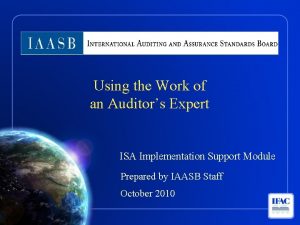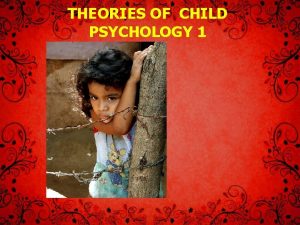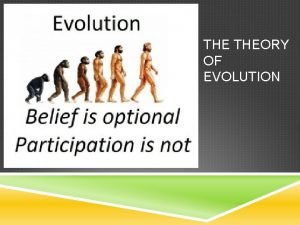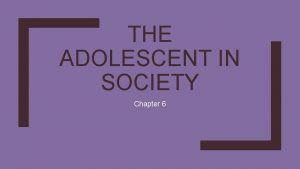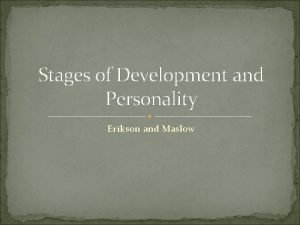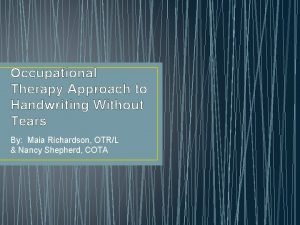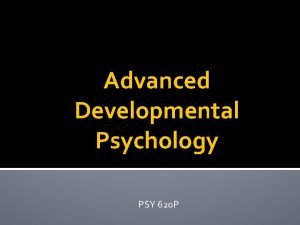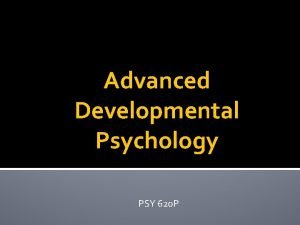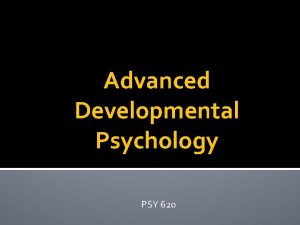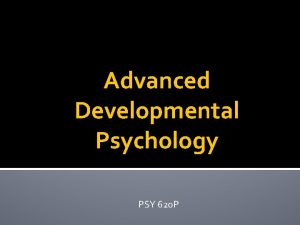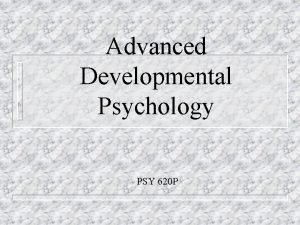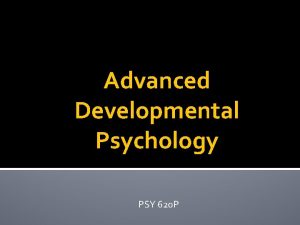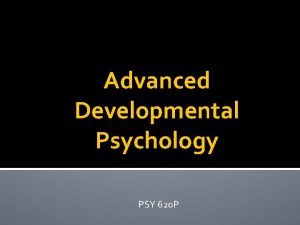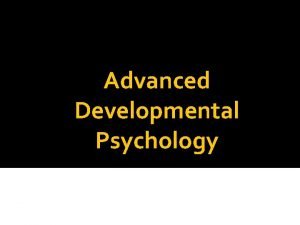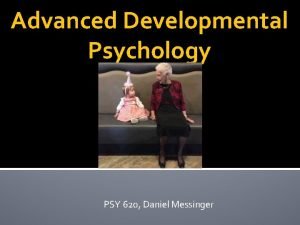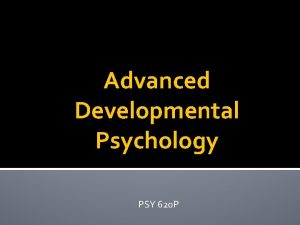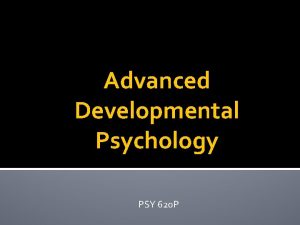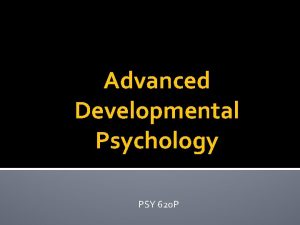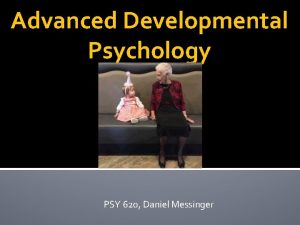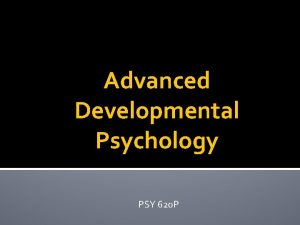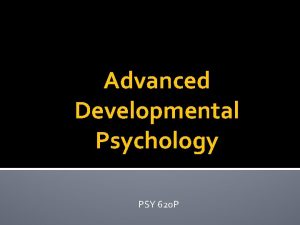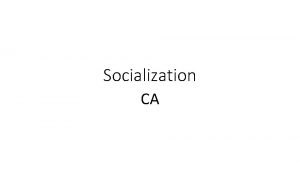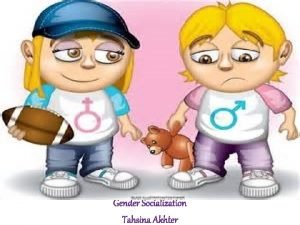Advanced Developmental Psychology PSY 620 P Socialization Processes





























































- Slides: 61

Advanced Developmental Psychology PSY 620 P

Socialization Processes �Parent-child relationships Face-to-face Attachment Sensitivity �Peer relationships �School/community

Introduction to Attachment Christine Sinicrope Messinger 3

Indiscriminate Social Responsiveness (0 to 8 weeks) �Signals that function to establish or maintain proximity of caregiver Based on ethological theories of emotional communication between infants and parents

Environment of evolutionary adaptiveness Protection from predators and. . . conspecifics Messinger 7

Attachment system �Inherent motivation �Organization of different behaviors Doesn’t matter how you get to caregiver �With single function �In a goal-corrected manner �Attachment as an organizational construct Messinger 8

Multiple attachments �Infants form attachments to many �A hierarchy is assumed caregivers In which infant turns first to primary caregiver �Role of fathers Messinger 9

What forms the basis for attachment relationships? (cont) �Harlow’s studies and the rejection of “drive reduction” explanations Spitz (1946) noticed that infants in orphanages (who were adequately nourished but had no loving attention) did very poorly Harlow’s surrogate mother studies examined relative influence of feeding vs. contact/comfort on attachment

Harlow’s Surrogate Mother Studies (cont) https: //www. youtube. c om/watch? v=hs. A 5 Sec 6 d. AI From Blum (2003)

Time is spent on cloth mothers � Both wire and cloth fed spend most of their time on cloth surrogate mother Regardless of which “mother” fed you Messinger 15

Attachment makes social contact a psychological reality �You carry feelings of being with other inside you Messinger 16

Internal Working Models �Mental representations of the availability of the attachment figure and what to do when the attachment system is activated �Mental rules for organizing, accessing, and limiting access to information relevant to attachment. �Impact individual differences in strange situation behavior and, hence, infant attachment classification. Messinger 17

What infant expects Evidence for Infants’ Internal Working Models of Attachment. 2007. Susan C. Johnson, Carol S. Dweck, and Frances S. Chen

Measuring attachment security �A construct (secure attachment) Is different than its measurement or operationalization �Attachment security can be measured with a Q-sort (an intricate rating system) �Prototypically measured with the Strange Situation (12 – 36 months at least) 19

Overall strategy �A – Avoidant Avoid caregiver �B – Secure Seek and be comforted by caregiver �C – Resistant Seek caregiving without surcease �D – Disorganized Lack a coherent strategy 20

Low Avoidance 15% RESISTANT SECURE 20% AVOIDANT rare DISORGANIZED High Avoidance High Displayed Anxiety Low Displayed Anxiety 65%

Measuring Attachment � Ainsworth’s (1978) Strange Situation Seven episodes increasing amount of stress (e. g. , unfamiliar environment, unfamiliar adult, brief separation from parent) How are attachment behaviors are organized around parent Attachment classification based primarily on reunion behaviors See example at: http: //www. youtube. com/watch? v=QTsew. Nr. HUHU (van Ijzendoorn) https: //www. youtube. com/watch? v=DRej. V 6 f-Y 3 c (Waters) Attachment examples ppt https: //nyu. databrary. org/volume/108/slot/10325/-? asset=28995

Attachment system �Stress activates the attachment system & reveals the child’s strategy �Security is an equilibrium �Avoidance is deactivation/shutting down �Resistance is over-activation/acting up 24

Basics �Most infants are attached but only 2/3 of infants are typically securely attached. �There is strong but limited experimental evidence and extensive evidence from metaanalyses that caregiver sensitivity predicts secure attachment �What does secure attachment predict? Messinger 28

Evidence for care-giving effects �Experimental Irritable infants Snugglies �Observational Meta-analysis of quasi-experiments Messinger 29

Experiment 1: Sensitivity training � 100 irritable, low-SES Dutch infants � 50 mothers in experimental group receive 3 home visits to foster “contingent, consistent, and appropriate responses to + and infant signals” � 50 control mothers are observed only Messinger 30

Results � Experimental infants 36/50 (72%) secure � Control infants: 16/50 (32%) secure � Sensitivity training for mother decreases rates of insecurity among irritable infants � Meta-analysis of intervention studies showed a moderately large effect size, d =. 48 Van den Boom Messinger 31

Experiment 2: Snuggly Effect! � 49 low-socioeconomic status (SES) mothers of newborn infants � Given soft baby carriers (more physical contact) or infant seats (less contact). � More experimental (83%) than control infants (38%) were securely attached at 13 mo. 3. 5 mo, mothers in the experimental group were more contingently responsive than control mothers to their infants' vocalizations. � Low cost experimentally-validated intervention? � Anisfeld, Casper, Nozyce, & Cunningham (1990). Does infant carrying promote attachment? An experimental study of the effects of increased physical contact on the development of attachment. Child Development, 61(5), 1617 -1627. Messinger 32

Meta-analysis: Sensitivity Studies Only �Perceive signals accurately and respond promptly and appropriately 22% (r =. 22), 7, 223 infants in 123 comparisons �Original Ainsworth subscale 24% (r =. 24), 837 infants in subset of 16 studies Socioeconomic class is a moderator ▪ Middle (r =. 27); lower (r =. 15) Messinger De Wolff, M. , & van Ijzendoorn, M. H. (1997). Sensitivity and attachment: A metaanalysis on parental antecedents of infant attachment. Child Development, 68(4), 571 -591. 33

Interactions with genes? � Barry et al. 2008 Messinger 36

Messinger 38

Empirical resolution? Insecure Avoidant Secure B 1, B 2 vs B 3, B 4 Low Insecure Resistant High Distress Reactivity Belsky; Sussman-Stillman; several replications

What about common genetic variant? � 5 HTTLPR (Serotonin-transporter-linked polymorphic region) Short (S) allele – Negative affect, Emotional Disorders, Reduced Serotonin, Increased Amygdala Activity ▪ Long allele variant (LG)— same as S allele Long allele noncarriers (LA)

Predicting security & distress reactivity

Attachment and Temperament Are they overlapping constructs? Fisher

Quick Detour �What is temperament? “…individual differences in emotion, motor, and attentional reactivity and regulation that are constitutionally based but also shaped by experience” �What is attachment? “…relational construct with origins in history of parent-child relationship Fisher

(Resistant) Fisher

Ongoing Debate Attachment Theorists Early attachment security is shaped by caregiving environment not temperament VS Temperament Theorists Variation in temperament yields individual differences in infant attachment �Is there a link between early attachment security and temperament? And if so, what is its strength? �Does variation in method matter? And how temperament is operationalized? Fisher

Current Study �Meta-analytic review of 131 samples (N=13, 018) �Estimated the association between early negative temperament (i. e. , negative and positive emotion reactivity) and (in)secure attachment Why is this important? Fisher

Hypotheses 1. 2. 3. 4. 5. 6. Early attachment insecurity will be weakly associated with negative temperament Negative temperament will be weakly negatively associated with avoidant attachment and positively associated with resistant attachment Negative temperament will be trivially associated with infant disorganization Temperament will be associated with attachment sub-classifications (high/low emotional reactivity) Negative temperament will be associated with B 3 -C 2 (high separation distress) Early insecurity will be more strongly associated with lower levels of social competence and greater externalizing and internalizing symptomology than with negative temperament Insecure father-child attachment would be weakly associated with negative temperament Fisher

Methods �Literature Search: 249 + 30 articles �Inclusion/Exclusion Criteria: Studies reporting on relationship between attachment and (all dimensions of) temperament Excluded studies that included peer competence, externalizing behavior, & internalizing symptoms Temperament measured by questionnaires; attachment observed (e. g. SSP) � 131 final, independent samples Fisher

Methods �Coding System and Moderators Type of measure/identity of attachment rater Type of instrument to assess temperament Measurement of temperament in relation to attachment Temporal relation of attachment and temperament assessments Demographics (child sex/ethnicity, country of study, SES, contextual risk of cohort) Fisher

Methods �Meta-Analytic Procedures 4 separate meta-analyses Moderator analyses Effect sizes (d) calculated as the standardized difference between secure and insecure attachment Random effects models 95% CI around point estimates; computed homogeneity Q statistics and p-values Fisher

Results: Security and Negative Temperament c Fisher

Results: Avoidant attachment and temperament Fisher

Results: Resistant attachment and temperament Fisher

Results: Comparing Attachment Classifications �Contrasts between resistant vs. secure attachment, and resistant vs. avoidant attachment were significant Resistant attachment showed stronger associations with temperament than secure or avoidant temperament �Children classified as A 1 -B 2 (low separation distress) versus B 3 -C 2 (high separation distress) in SSP did not differ in negative temperament Fisher

Results: Dimensions and Assessment of Temperament & Father-Child Attachment �Association between negative temperament and attachment did not differ based on theoretical or dimensional classification Resistance more strongly associated with fearful distress vs. positive emotionality �Association also did not differ based on temperament assessment �Father-child attachment was not related to negative temperament Fisher

Results: Temperament, Social Competence, Externalizing Behavior, and Internalizing Symptoms Fisher

Conclusions �Association between temperament and attachment security is weak Temperament is moderately associated with resistant attachment �Comparable to the weak association between attachment security and internalizing symptomatology Significantly weaker than association between attachment security and social competence and externalizing symptoms Fisher

Discussion 1. 2. 3. 4. 5. 6. 7. 8. What do these findings mean for the debate between attachment and temperament scholars? Both sort of wrong? Could there be a third variable at play, influencing these constructs? Only resistant attachment linked to negative temperament; what do you make of suggestion that resistant children show higher negative temperament than secure and insecure-avoidant children? How do you make sense of null findings for disorganized attachment and negative temperament? Why do you think a stronger association between avoidant attachment and negative temperament was observed only among boys? Why do you think concurrent assessment of attachment and temperament yielded a stronger association between avoidant attachment and negative temperament? When including studies that only used the SSP, combined effect size decreased to less than. 1; how do you interpret this? Any methodological strengths and/or limitations? Future directions; Differential Susceptibility Framework? Fisher

The Big Question �How do early experiences of attachment relationships impact later relationships? �Through behavioral and then internal representations of what can be expected from relationships Messinger 66

Predicting behavior problems

Double insecurity behavior problems (insecurity with dad is key) Messinger 72

Attachment and Children's Peer Relations � “Small-to-moderate” association between attachment security to mother and quality of children’s peer relations meta-analysis of 63 studies indicates � Effects “higher for studies that focused on children's close friendships rather than on relations with other peers. ” Effects larger after early childhood ▪ “Gender & cultural differences … minimal” ▪ A Quantitative Review (Schneider et al ’ 2001) Messinger 75

Disorganized externalizing Disorganized/Nonsecure Internalizing/Externalizing Based on 42 independent samples (N = 4, 614), Messinger (Groh, Roisman, van Ijzendoorn, Bakermans. Kranenburg, & Fearon, 2012) 76

Attachment-Maturation Model � Early menarche: insecure overrepresented � Is insecurity a better fit to certain environments? Belsky, Houts, & Fearon 2010 Mattson controlled for mother’s age of menarche

What about attachment in adulthood?

How Speakers are Categorized � As Autonomous (secure), Dismissing (avoidant), or Preoccupied (resistant) And, independently, as Unresolved/Disorganized � Not based on experiences themselves � But on speaker’s current relationship to the experiences how they’ve processed their past � Based on the coherence of their discourse Messinger 79

Validity of AAI �Classifications are stable 2 months, 3 months, 1. 5 years �Not related to IQ measures 6 of 7 studies �Discourse style relates to attachment not interviews about job �Machine learning shows some ability to distinguish adult attachment in AAI Messinger 80

Parent-Infant Attachment Correspondence � Meta-analysis of 13 studies using three major categories � 75% secure vs. insecure agreement (K=. 49) � 70% three-way agreement (K=. 46) Prebirth AAI show 69% three-way agreement (K=. 44) �Bakermans-kranenburg, M. J. & Vanijzendoorn, M. H. (1993). A Psychometric Study of the Adult Attachment Interview - Reliability and Discriminant Validity. Developmental Psychology, 29, 870 -879. Messinger 81

Parent-Infant Correspondence Messinger 82

Breaking the Link �Parental attachment is not formed by past experiences but by current orientation to past. �Supportive experiences with a partner, friend or therapist can allow for earned autonomy in the face of experiences that would otherwise be associated with insecurity. Messinger 83

Interview �Interview a partner about one attachment figure focusing on questions 2 through 4 �Each person analyzes their own responses no comments form partner �Only share what you want to share Messinger 84

Adult Attachment Interview Messinger 85

How to Think About What You’ve Said � Scales associated with autonomous category coherence, metacognitive monitoring � Scales associated with dismissing category Idealization of attachment figures, insistence on lack of memory for childhood, dismissal of attachment-related experience/relationships � Scales associated with preoccupied category anger expressed toward attachment figure, passivity/vagueness in discourse Messinger 86
 Concurrent in os
Concurrent in os Ap psychology unit 9
Ap psychology unit 9 Lawrence kohlberg developmental psychology
Lawrence kohlberg developmental psychology Research methods in developmental psychology
Research methods in developmental psychology History of developmental ideas in psychology
History of developmental ideas in psychology Attachment developmental psychology
Attachment developmental psychology Personal fable ap psychology
Personal fable ap psychology Devonte is a graduate student in developmental psychology
Devonte is a graduate student in developmental psychology Authoritariam
Authoritariam Ucf psych advising
Ucf psych advising Regression
Regression Middle childhood psychology
Middle childhood psychology Chapter 5 developmental psychology
Chapter 5 developmental psychology Euro psy
Euro psy Psy2055
Psy2055 Psy 2055
Psy 2055 Psy2055
Psy2055 Psy
Psy Psy sanin
Psy sanin Psy
Psy Psy
Psy Psy
Psy Psy
Psy Psy 226
Psy 226 Suppose twin teenagers are vying
Suppose twin teenagers are vying Alla kulikova
Alla kulikova Damasio
Damasio Psy walsh
Psy walsh Najlepsi polovnicky pes
Najlepsi polovnicky pes Pomnožné podstatné mená
Pomnožné podstatné mená 11 psy
11 psy Regression psy
Regression psy Psy
Psy Psy 335 purdue
Psy 335 purdue Packing inst.
Packing inst. 12vac35-105-160
12vac35-105-160 Toefl 勉強
Toefl 勉強 Here is where your presentation begins
Here is where your presentation begins Trigo variedad jacaranda
Trigo variedad jacaranda Jms 620
Jms 620 Data domain dd630
Data domain dd630 Arinc 620
Arinc 620 Meam 620
Meam 620 Aruba controller設定
Aruba controller設定 Julius caesar buildings
Julius caesar buildings Isa 620 using the work of an expert
Isa 620 using the work of an expert Krs 620
Krs 620 Positive psychology ap psychology definition
Positive psychology ap psychology definition Altruistic
Altruistic Social psychology ap psychology
Social psychology ap psychology Psychology studies
Psychology studies Social psychology is the scientific study of
Social psychology is the scientific study of Health psychology definition ap psychology
Health psychology definition ap psychology Developmental stage theories
Developmental stage theories Developmental homology
Developmental homology Glickman's developmental supervision model
Glickman's developmental supervision model Undefined status adolescence
Undefined status adolescence Sota conference
Sota conference Maslow vs erikson
Maslow vs erikson Da form for counseling
Da form for counseling Denver developmental screening test
Denver developmental screening test Handwriting without tears occupational therapy
Handwriting without tears occupational therapy

